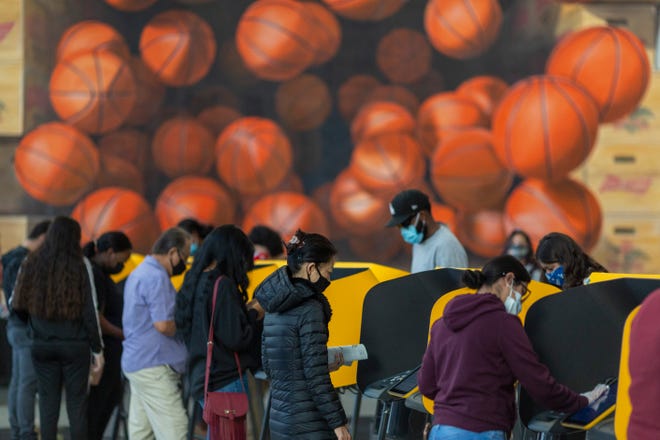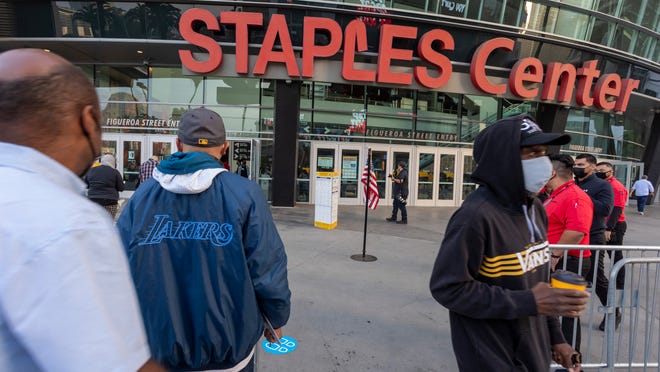LOS ANGELES — Shabazz Williams walked out of Staples Center on Election Day wearing a Lakers jersey and a team-branded face mask, his civic duty complete.
Williams, 38, knew that he could have voted at a polling site closer to his home in Sherman Oaks, which is about a 15-minute drive from downtown Los Angeles. But where’s the fun in that?
Instead, the Lakers fan donned a jersey and drove to the team’s home arena, where he said it took him no more than 15 minutes to fill out his ballot.
“I go to Staples Center every year to games,” Williams said, “and this would have been the first year I didn’t go.”
Similar scenes played out in major metropolitan areas across the country last week, as dozens of professional and college sports facilities joined the election process — most, like Staples Center, for the first time.
HE’LL PASS:At Masters, Nicklaus passes up chance to tell Trump how to lose with dignity | Opinion
SEASON CANCELED:Ivy League cancels entire winter sports season

Some venues became vote-counting hubs, or hosted voter registration drives. Others served as drop-off locations for mail-in ballots. And dozens pro arenas or stadiums welcomed in-person voters, either on or before Election Day.
“I think it’s neat that they were able to do it right here at the stadium,” said Kansas City Chiefs coach Andy Reid, who cast his ballot at Arrowhead Stadium on Election Day.
The use of sports arenas as polling places was symbolic, to an extent — another way for leagues and teams to show that they support the cause. But there was also a tangible impact behind the gesture.
‘WE DON’T HAVE TO WAIT’:Chiney Ogwumike turns message into action by becoming Election Day clerk
USA TODAY Sports contacted local election officials and compiled voter turnout data from 29 counties in which 40 professional arenas and stadiums were used as voting locations. The data showed that more than 298,000 people cast their ballots at those venues in one method or another. (Many counties were only able to provide partial data immediately after the election, and officials in New York, which had voting at two sports venues, did not reply to repeated requests for its figures.)
Benjamin Hovland, the chairman of the U.S. Election Assistance Commission, said the availability of sports arenas and stadiums “absolutely made a difference” in helping the election run smoothly amid the COVID-19 pandemic.
“What we saw with so many of these (sports) facilities is when they volunteered, when they made themselves available, that solved major problems for election officials,” said Hovland, whose agency provides federal support for state and local election officials.
‘A no-brainer’
As late spring turned to early summer, election officials across the country saw the beginnings of a looming challenge.
The death of George Floyd and nationwide movement for social justice led to an increase in voter interest and enthusiasm, which meant their facilities would likely need to accommodate more voters than in previous years. But the ongoing pandemic also meant that some of their traditional polling places, such as senior centers and schools, would be unavailable.
Replacement venues needed to check a list of boxes. They had to be large enough to allow for social distancing, with reliable internet, ample parking, security features, ADA accessibility, and proximity to public transportation, for starters. They also had to be available for six weeks, in some instances.
“Sometimes people don’t realize everything that (a voting center) needs,” said Paul Gronke, a professor of political science at Reed College.
“When these sports facilities started coming in, I think (for) a lot of people in my community, it was one of those head-slapping moments. Like boy, that’s obvious isn’t it? It really is. They have all of these characteristics.”

NBA teams were the first to offer their arenas as voting sites, as part of an agreement with the players’ association following the shooting of Jacob Blake in Kenosha, Wisconsin. Twenty-three teams made arenas and practice facilities available for voting and voting-related activities, including early voting, poll worker training locations, ballot-drop offs, non-partisan voter registration events and Election Day voting.
In Washington, D.C., Wizards executives, coaches and players greeted voters at Capital One Arena on Election Day. Coach Scott Brooks, who lives a few blocks from the arena, voted there. In Chicago, twice as many people voted at United Center than any other universal voting site or precinct, according to the Chicago Board of Election Commissioners. And more than 30,000 people voted at Dallas’ American Airlines Center and New Orleans’ Smoothie King Arena.
No professional sports arena, however, welcomed more voters than the Atlanta Hawks’ State Farm Arena, according to USA TODAY Sports’ data.
Nearly 40,000 Fulton County residents voted at the arena during early voting in Georgia, a key state in which Joe Biden holds a narrow lead over Donald Trump. The team wanted to provide a non-partisan site without long waiting times. With 302 voting machines at physically-distanced locations, poll workers kept lines moving even when there were 3,000 people per day during the first week of early voting.
“The biggest thing for us was taking that initial step,” Hawks coach Lloyd Pierce said. “We were the first team to activate our arena. It’s an idea, thought and action item that came to fruition. It started off as idea and then became a no-brainer. … We were really proud as an organization to pull it off.”
Pierce, who volunteered as a greeter for early voting, said he will never forget the dad who brought his son to vote for the first time. Hawks CEO Steve Koonin said watching people vote in the arena was “much more emotional than I ever thought it would be.”
Koonin relayed the story of an 80-year-old Black man who used a walker. The man told Koonin he hadn’t voted in 30 years because he didn’t think his vote made a difference. He put his ballot in the machine, the machine said his vote had been accepted, and the man started crying.
“We were helping our state, and our city, take part in the democratic process,” Koonin said. “Also, we were helping to make voting easier. That’s how it should be. No one should wait in line for 10 hours to vote, or vote in a Kiwanis club or library. Nothing against those places but voting should take place in large venues.”
The start of a trend?
In Los Angeles, the use of sports venues like Staples Center and Dodger Stadium was part of a broader shift toward a vote center model – which could become a trend. Instead of being assigned a specific polling place, the county set up several hubs and invited its residents to cast their ballots at a location of their choosing.
University of Rhode Island assistant professor Gretchen Macht and her team spent Election Day observing some of these sites through the URI VOTES project, which seeks to use data to improve voting procedures. At Dodger Stadium, she saw waves of fans in team gear who decided to vote there almost as a means of celebrating the team’s recent World Series title. First-time voters were greeted with cheers from poll workers.
“If you’re a first-time voter, what better of a place to go and exercise your right to vote than someplace that will be memorable like that?” Macht said. “I think that holds some value.”
Staples Center and Dodger Stadium were each among the highest-grossing vote centers in the county, in terms of turnout. And Los Angeles County Registrar-Recorder/County Clerk Dean Logan wrote in an email that his office saw signs of excitement about voting at those sports venues, and others – though many people still chose to vote at a community center or city hall in their immediate neighborhood.
“Professional sporting venues and their corresponding franchises played an important role in the general election,” Logan wrote. “Not only in serving as a vote center, but as a community partner in civic engagement and enfranchisement.”
Hovland, the federal voting official, said it’ll be difficult to quantify the impact that sports arenas and stadiums had on the 2020 election due to the variances from county to county, and the prevalence of mail-in voting. But he suggested they might have influenced even voters who cast their ballots elsewhere.
“Maybe I didn’t go to the Pepsi Center because that wasn’t my location in downtown Denver, but I saw that and thought it was cool. And then I went and looked up where I was supposed to vote, and went and voted, because I saw that,” Hovland said.
He also credited the sports world for its voting efforts beyond the use of arenas and stadiums. Professional and college teams, for example, held voter registration drives to ensure that all of their athletes were signed up to vote. And Lakers star LeBron James created an organization called “More Than a Vote” that, among other things, recruited 40,000 people to serve as poll workers.
The use of sports venues as polling places this year was, at its core, a one-time solution to the one-time challenges presented by COVID-19. In fact, in a normal year, many of the venues that were used for voting would have otherwise been hosting games or other events, such as concerts.
But experts and election officials hope their partnerships with sports organizations will continue – and that voting at a stadium or arena could become common.
“A sports arena has a sort of community feeling. There’s the fan base, and the sense that it’s a gathering place,” said Gronke, the political science professor.
“I hope that those (arenas) become a trend. I don’t know if it will be. But I hope it does.”
Contributing: Peter Barzilai and Mike Freeman
Follow the reporters on Twitter @joshlpeter11, @Tom_Schad and @JeffZillgitt.



